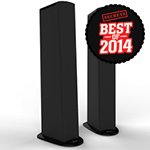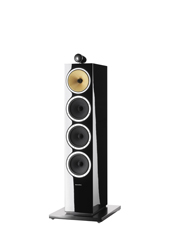
Introduction to the B&W CM10 Speakers
B&W 601S2s were the first loudspeaker I ever bought for myself. Charged on a credit card in college, and beyond what I should have spent, they wound up saving me hundreds of dollars in the long run. With their intoxicating sound, far beyond anything I’d owned before, I’d spend hours listening to them. With a 300-disc CD changer and a La-Z-Boy recliner, many nights and weekends were spent listening to albums uninterrupted.
While those B&Ws were left behind many upgrades ago, their memory has remained strong. No matter what speaker I have owned since there is a little yearning in my mind for that B&W sound. As soon as the new CM10 tower speaker was introduced, I set out to spend some quality time with it and return to where the audiophile in me was born.
B&W CM10 SPEAKERS SPECIFICATIONS
- Design: 3-Way, Ported Enclosure
- Drivers: One 1″ Dual Layer Aluminum Dome Tweeter, One 6″ Woven Kevlar FST Midrange, Three 6.5″ Paper/Kevlar Woofers
- MFR: 45 Hz – 23 kHz, ± 3 dB
- Sensitivity: 90 dB/1W/1m
- Harmonic Distortion: 2nd and 3rd harmonics (90 dB, 1m), <1% 86 Hz – 28 kHz , <0.5% 110 Hz – 20 kHz
- Nominal Impedance: 8 Ohms
- Power Handling: 30-300 Watts
- Size: 42.8″ H x 7.9″ W x 13.3″ D
- Weight: 73.7 Pounds/each
- MSRP: $3,999/pair
- Bowers & Wilkins
- SECRETS Tags: Bowers & Wilkins, B&W, Speakers, Audio, Stereo
The Design and Setup of the B&W CM10 Speakers
The CM line from B&W has been out for a few years now and includes bookshelves, center channels, towers, and a subwoofer. The CM10 is the first model in it to include the B&W tweeter in an external pod like their top of the line 800 Diamond series models. This design helps isolate the tweeter from the rest of the cabinet and help with dispersion.
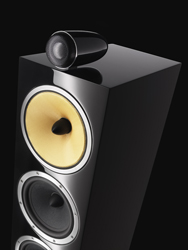
Moving it outside of the cabinet also creates space for a third driver compared to the CM9 speaker. With a 1″ tweeter to handle treble and a 6″ Kevlar cone midrange, there are three 6.5″ paper/Kevlar cones for bass as well as a rear port. With this large assortment of drivers the B&W CM10 is rated to extend down to 28 Hz making it nearly fully range.
All of this fits into a relatively small tower, available in a variety of finishes. Mine came in Piano Black and looked stunning. The finish on them is a bit too sharp-looking for a home theater room as they do a good job of reflecting the image from my projector as well. In a projection room I would opt for one of the wood grain finishes and save the piano black for a family room where I can show it off.
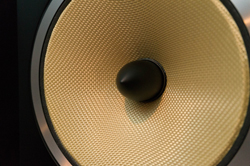
Setting up the CM10 is easy but does take time. They are a heavy speaker and well packaged and I recommend using a friend for placement. I secured the bases and spikes myself and them moved them into position. Fine placement is hard to do with the spikes by myself as the weight lets them dig into the carpet. I eventually settled on them being very wide in my room, with a bit of toe in, to produce the largest image.
Over a few weeks I drove the B&W CM10s with a variety of amplifiers, from a Halo A31 to an Arcam receiver and an Anthem Integrated. With an 8 ohm nominal load and 90 dB sensitivity I never had an issue pushing them to the levels I desired. I experimented with the port plugs but preferred the extension with them installed. I didn’t hear any port chuffing or other issues that would cause me to use them with the CM10s.
The B&W CM10 Speakers In Use
I have a standard playlist I use to listen to everything that comes into my theater. Each piece of music typically has something I am listening for, and cues for me to pick up on. With the B&W CM10 it was apparent right away that it is not a fan of the loudness wars. Tracks with lots of dynamic compression and it did not coexist well.
“Reckoner” off Radiohead’s In Rainbows is a gorgeous song with a sub-par mastering. As much as I love the song I moved on quickly with the CM10s. The cymbal crashes are harsh and unforgiving and fall flat. The soundstage is large and deep and the instruments are there, but the CM10 does the song no favors. I can pick up little drums at the end of the song that had escaped my attention in the past. Perhaps they’ve always been there, waiting for me to discover them, but my usual speakers could not separate them from the rest of the sounds.
As soon as Natalie Merchant’s “Carnival” started the CM10 morphed into a different speaker. Drums are tight and detailed with none of that flatness to them. Natalie Merchant sounds as gorgeous as she ever does. Her voice is smooth and clear but it is always the drums that pull me in here. Tight, clean, and full-bodied.
The real killer from the CM10s is “So What” from Miles Davis. The saxophone is just glorious. Packing tremendous weight and feel without any extra brassiness or harshness. Where bits of Reckoner would start to split my ears the sax here just sounds like a sax. Nothing more, nothing less, just closer to the real thing than I’ve heard in my home.
Counting Crows August and Everything After has not sounded better than on its DSD download or SACD release. Even when the album really starts to take off and build into a giant wall of sound the CM10 does not fatigue my ears. It sounds big and bold, and fills the room with its sound. With the Blu-ray Pure Audio version of Beck’s Sea Change the picture thrown by the CM10s is amazing in size. Filling the front of the room you’ll check to ensure you didn’t select the 5.1 channel track instead of stereo. The soundstage moves out well past the limits of the speakers while reaching clear to the ceiling. The CM10 has a gigantic image that is not trapped inside a box.
Blu-ray films sound great on the CM10. The classic Dave Matthews & Tim Reynolds Live at Radio City disc is first-rate. The metallic strum of a guitar is captured by the CM10 with just a little bit more top-end than some speakers. Vocals on films like Argo and Drive are crisp and clear. B&W has a matching center for the CM10s but run in stereo mode they still make a movie sound fantastic.
With my over-compressed musical tastes, I found I could get around their harshness using the vinyl version over my digital copies. Daft Punk’s Random Access Memories sounds great on the CM10 off vinyl but you wouldn’t want to listen to the CD version of it. Recent Radiohead albums also sound great on vinyl but harsh on CD. I can see why younger people can drift away from higher-end audio when it only serves to show off the flaws of their favorite albums.
Measurements
Frequency response for the B&W CM10 was measured in-room using RoomEQ Wizard and a calibrated microphone. A 1 kHz test tone was used to set the output level to 90 dB and then 48 total measurements were taken, 8 measurements at 6 locations, and then averaged to get an in-room response. I measured with both the port plug in and out.

With the rear port open we see a good frequency response that starts to roll-off around 15 kHz and offers bass extension well down below 40 Hz. There is a small dip at 180 Hz
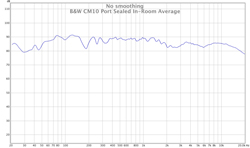
With the port sealed the response is almost identical except it falls off a bit faster at the bottom end. Below 40 Hz the open port offers an average of 6 dB greater output compared to the sealed configuration.
Conclusions about the B&W CM10 Speakers
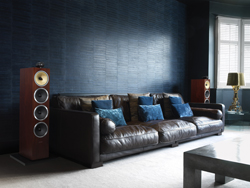
The B&W CM10s are like a Black Diamond ski slope: capable of bringing out the absolute best in those that go down it, but also exposing all weaknesses. Fed with high quality content they deliver great realism and detail. The saxophone on “So What” has never been presented in my listening room as well as it has from the CM10s.
Pass them overly compressed, dynamic limited material and they are unforgiving. The lower-quality content comes across in just that way: bright, harsh, and abrasive. The honesty of the CM10s is unrelenting and you must be prepared to properly feed the beast.
Do I fault the CM10 for being brutally honest? No, I can’t blame it for the faults of the recording engineers that come before it. Thinking back to my first pair of B&Ws, all my favorite recordings from then still sound wonderful on the CM10s. The B&W voicing still appeals to my ears and lets me sit back and enjoy the wonderful music. When I pull out my favorite albums from the 15 years since then is when I begin to shy away.
My feeling on the CM10 break down to what you listen to. If you listen to modern alternative, pop, or rock music that is mastered too loudly and isn’t on vinyl, you’re probably not going to love the CM10. Like a sports car that wants premium gas, it won’t perform well with that. If you listen to more classic rock, jazz, classical, or other well-recorded music you won’t need to worry. The CM10 will sound wonderful and show off what it can do. It isn’t the speaker that best matches my musical tastes, but it might be in line with yours.


